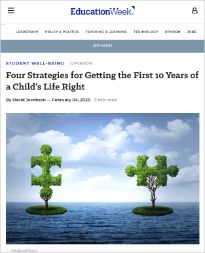Two divides thwart the best efforts of American educators to improve outcomes for low-income children and their families.
The first is the gap between early-childhood and K-12 education. The second is between K-12 education and health and social services. Typically these institutions operate in silos. Yet decades of research confirm that to best learn and thrive, children need early-childhood and elementary education to be aligned so that each year builds upon the last, and they need health and social services to be coordinated to maximize their positive impact.
Over the past decade, I’ve had the opportunity to research and work with communities that are attempting to bridge these divides. I recently completed a two-year study, funded by the Heising-Simons Foundation, of school and community partnerships across the country that are at the forefront of building more coherent and integrated local systems of care and learning. I visited these communities and interviewed superintendents, principals, preschool directors, community leaders, and many preschool and elementary school teachers. Despite working independently, these communities have diagnosed similar challenges to improving supports for children and families. In response, they are converging on a common set of innovative structures and strategies.
These partnerships are motivated by a commitment to educational equity and the goal that all children learn and thrive. They are focused on improving children’s experiences during the first decade of their lives, and thus I refer to them as “First 10″ schools and communities. In some cases, First 10 partnerships encompass an entire district or a large zone within a district and support all the elementary schools, Head Start programs, community-based preschools, and child- and family-serving organizations within this geographic area. In others, a single elementary school will serve as a hub to provide resources to children ages 0-4 and their families, while also collaborating with nearby early-childhood programs. Either way, successful First 10 schools and communities take four important steps in their efforts to improve outcomes for children and families that together provide a roadmap for other communities.
